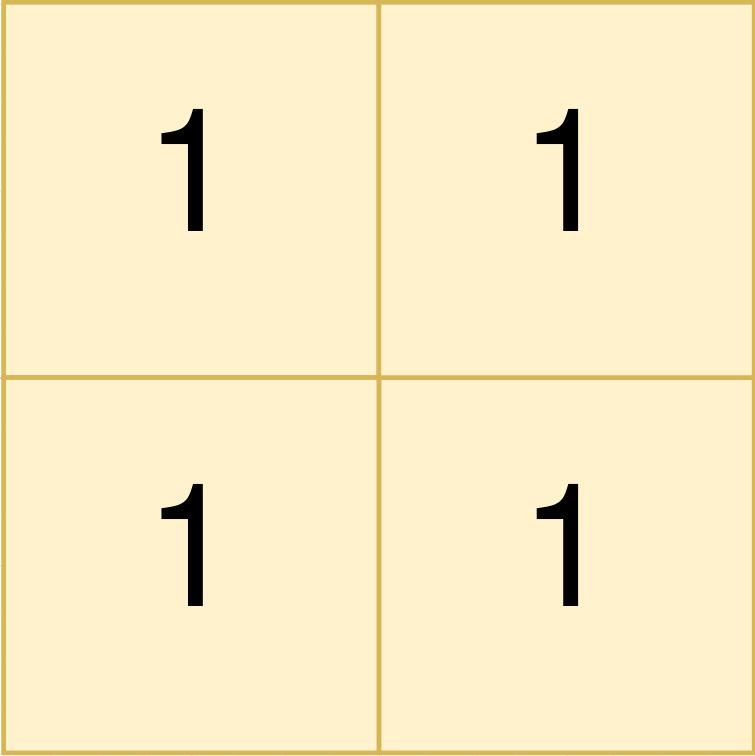


题目描述
给你一个下标从 0 开始,大小为 m x n 的二进制矩阵 land ,其中 0 表示一单位的森林土地,1 表示一单位的农场土地。
为了让农场保持有序,农场土地之间以矩形的 农场组 的形式存在。每一个农场组都 仅 包含农场土地。且题目保证不会有两个农场组相邻,也就是说一个农场组中的任何一块土地都 不会 与另一个农场组的任何一块土地在四个方向上相邻。
land 可以用坐标系统表示,其中 land 左上角坐标为 (0, 0) ,右下角坐标为 (m-1, n-1) 。请你找到所有 农场组 最左上角和最右下角的坐标。一个左上角坐标为 (r1, c1) 且右下角坐标为 (r2, c2) 的 农场组 用长度为 4 的数组 [r1, c1, r2, c2] 表示。
请你返回一个二维数组,它包含若干个长度为 4 的子数组,每个子数组表示 land 中的一个 农场组 。如果没有任何农场组,请你返回一个空数组。可以以 任意顺序 返回所有农场组。
示例 1:

输入:land = [[1,0,0],[0,1,1],[0,1,1]]
输出:[[0,0,0,0],[1,1,2,2]]
解释:
第一个农场组的左上角为 land[0][0] ,右下角为 land[0][0] 。
第二个农场组的左上角为 land[1][1] ,右下角为 land[2][2] 。
示例 2:

输入:land = [[1,1],[1,1]]
输出:[[0,0,1,1]]
解释:
第一个农场组左上角为 land[0][0] ,右下角为 land[1][1] 。
示例 3:

输入:land = [[0]]
输出:[]
解释:
没有任何农场组。
提示:
m == land.lengthn == land[i].length1 <= m, n <= 300land 只包含 0 和 1 。- 农场组都是 矩形 的形状。
解法
方法一
1
2
3
4
5
6
7
8
9
10
11
12
13
14
15
16
17
18
19 | class Solution:
def findFarmland(self, land: List[List[int]]) -> List[List[int]]:
m, n = len(land), len(land[0])
ans = []
for i in range(m):
for j in range(n):
if (
land[i][j] == 0
or (j > 0 and land[i][j - 1] == 1)
or (i > 0 and land[i - 1][j] == 1)
):
continue
x, y = i, j
while x + 1 < m and land[x + 1][j] == 1:
x += 1
while y + 1 < n and land[x][y + 1] == 1:
y += 1
ans.append([i, j, x, y])
return ans
|
1
2
3
4
5
6
7
8
9
10
11
12
13
14
15
16
17
18
19
20
21
22
23 | class Solution {
public int[][] findFarmland(int[][] land) {
List<int[]> ans = new ArrayList<>();
int m = land.length;
int n = land[0].length;
for (int i = 0; i < m; ++i) {
for (int j = 0; j < n; ++j) {
if (land[i][j] == 0 || (j > 0 && land[i][j - 1] == 1)
|| (i > 0 && land[i - 1][j] == 1)) {
continue;
}
int x = i;
int y = j;
for (; x + 1 < m && land[x + 1][j] == 1; ++x)
;
for (; y + 1 < n && land[x][y + 1] == 1; ++y)
;
ans.add(new int[] {i, j, x, y});
}
}
return ans.toArray(new int[ans.size()][4]);
}
}
|
1
2
3
4
5
6
7
8
9
10
11
12
13
14
15
16
17
18
19
20
21 | class Solution {
public:
vector<vector<int>> findFarmland(vector<vector<int>>& land) {
vector<vector<int>> ans;
int m = land.size();
int n = land[0].size();
for (int i = 0; i < m; ++i) {
for (int j = 0; j < n; ++j) {
if (land[i][j] == 0 || (j > 0 && land[i][j - 1] == 1) || (i > 0 && land[i - 1][j] == 1)) continue;
int x = i;
int y = j;
for (; x + 1 < m && land[x + 1][j] == 1; ++x)
;
for (; y + 1 < n && land[x][y + 1] == 1; ++y)
;
ans.push_back({i, j, x, y});
}
}
return ans;
}
};
|
1
2
3
4
5
6
7
8
9
10
11
12
13
14
15
16
17
18 | func findFarmland(land [][]int) [][]int {
m, n := len(land), len(land[0])
var ans [][]int
for i := 0; i < m; i++ {
for j := 0; j < n; j++ {
if land[i][j] == 0 || (j > 0 && land[i][j-1] == 1) || (i > 0 && land[i-1][j] == 1) {
continue
}
x, y := i, j
for ; x+1 < m && land[x+1][j] == 1; x++ {
}
for ; y+1 < n && land[x][y+1] == 1; y++ {
}
ans = append(ans, []int{i, j, x, y})
}
}
return ans
}
|





